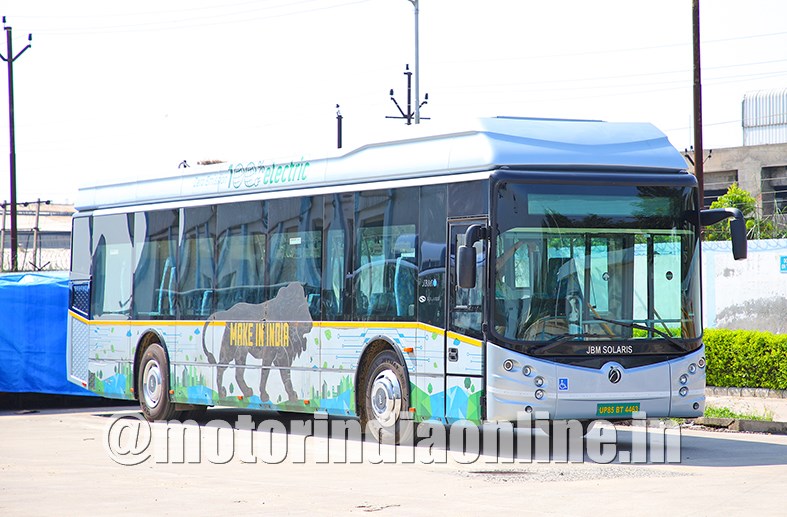Driving an electric bus is not just fascinating, but offers a different kind of CV motoring experience that will shape the future. The more you get to know this bus, the more complex and interesting it becomes. Senior Correspondent and Test Driver Dhiyanesh Ravichandran finds out the nuts and bolts of electric bus driving after spending a day with ECO-LIFE low-floor on the test track
A lot has happened since the 20th century in the lives of humans, proffering practical and tangible enhancements to the way they were living for ages, while also adding unwarranted complexities, fairly speaking. And if you were to find a common connecting factor behind all such transformations that human civilisation has gone through, and continues to, like never before, what could be more pertinent than the discovery of electricity and tons of inventions that applied the phenomenon into domestic and industrial uses? Indeed, not up until brilliant minds like Benjamin Franklin conducted extensive research, including his famous thunderstorm experiment in 1752, and a series of others who followed him in the next century, electricity turned from a mere intellectual curiosity into an essential tool of modern life in the centuries that followed.
But ironically, the discernment that advances in electrical science could transform the motoring and mobility needs of people sustainably did not catch up around the time when it was already overtaking steam engines in automobiles. A century later, here we are again, realising that electricity is the panacea to a fossil-fuel-free, extraordinary future of motoring! From what we have seen and heard thus far in the last two decades or so, electric propulsion systems are steadily replacing internal combustion engines in automobiles.
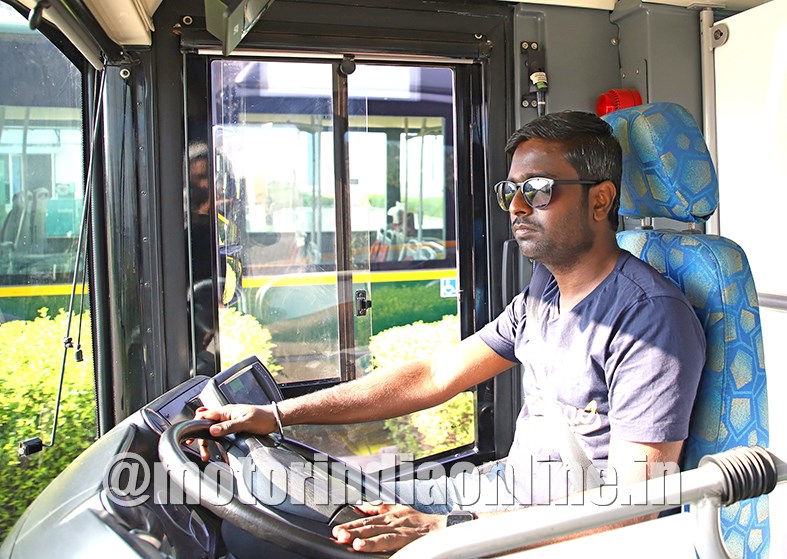
It’s just a matter of time before all private passenger vehicles and buses plying on our roads are electrified – trucks may join the club a little later. One way or the other, it’s imminent and bound to happen someday. But the critical question among most of the automotive professionals is on enhancements and value-additions that e-mobility can contribute to motoring, on the premise that a lot of advances could have happened in this undue transition. Is e-mobility a progressive revolution or just an ineluctable mediocrity being imposed upon us for a noble cause?
Unnerving proposition
Well, we at MOTORINDIA decided to find some satisfying answer to that pertinent question, in the context of buses. Considering the phenomenal amount of momentum that electric buses have received in the last five years, it is clear that all cities in India are to emulate what Shenzhen in China has achieved today, with its all-electric fleet of city buses. On the other hand, it is only in recent times that city buses in India have evolved significantly, from the era of truck-chassis built standard buses to specialised low-entry and low-floor buses equipped with essential technologies, thereby greatly easing out things for both drivers and passengers.
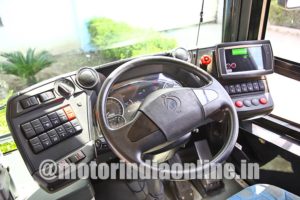
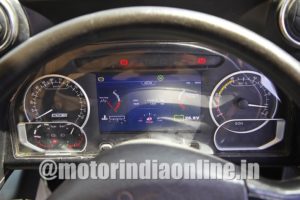
You may wonder who cares about driving experience in buses anyway, but I do and people like me do exist! The time when you think that the golden era of bus driving has just begun, the bomb of electrification has been unnerving. How different are electric buses to drive and work with? What aspects of driving make them distinct and progressive, as against regular diesel or CNG-powered ones? What are those areas where e-buses succumb to their conventional rivals? JBM Buses, a prominent bus maker in India that has also ventured into the e-bus race, suggested that their flagship JBM Solaris ECO-LIFE 12M battery-electric bus may hold essential clues to our questions. They also opened the test track at their Kosi Kalan bus facility for us to conduct the necessary experimentation with the electric bus.
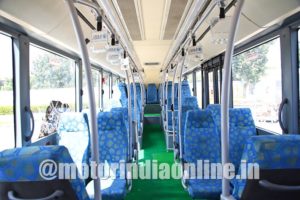
At the outset, I have to confess that I am a little old-school. The rattles of an idling diesel engine and a piercing howl while stepping up the gas are something I like in city buses. The time when I was waiting for the ECO-LIFE e-bus at the test track, I had no clue about the bus coming towards me from behind, except for the hissing noise of the pneumatic doors being opened. They are very quiet and silent, I knew that already, but that’s when I realised that this can be problematic, or even deadly, for pedestrians and passengers waiting at the bus shelter. Drivers have to be even more alert and proactive in signalling their presence in such situations.
We are so much used to such extensive noise-vibration-harshness (NVH) levels that once they are ripped off, we hardly get that essential feel of being on a bus. The first thing I did after settling in the driver seat comfortably was to turn the key on and off a couple of times to ensure that the ignition is on! Except for the full-lit instrumentation and HVAC blower noise, there is no other sign of the bus all set to go. I then sought the button to push the bus to the ‘Drive’ mode – we are used to this one at least. With the advent of fully-automatic transmissions and AMT systems in low-floor buses, the need for rowing gears manually is eliminated. In this electric bus, there is no need for a mode selector either; just two multi-functional buttons are good to go!
Lively drive
Unlike a conventional low-floor bus with automatic gearbox, the bus doesn’t crawl forward once put in ‘D’ mode. I lightly stepped on the gas pedal and the vehicle started moving instantly without any clamour. There is instantaneous power and torque, while the power delivery is very smooth and seamless. The bus feels eager to go; it simply wants to lunge forward like a soaring rocket! Since the high-torque traction motors are designed to interface directly with the standard rear differential, the absence of an intermediate gearbox provides for almost instant throttle response.
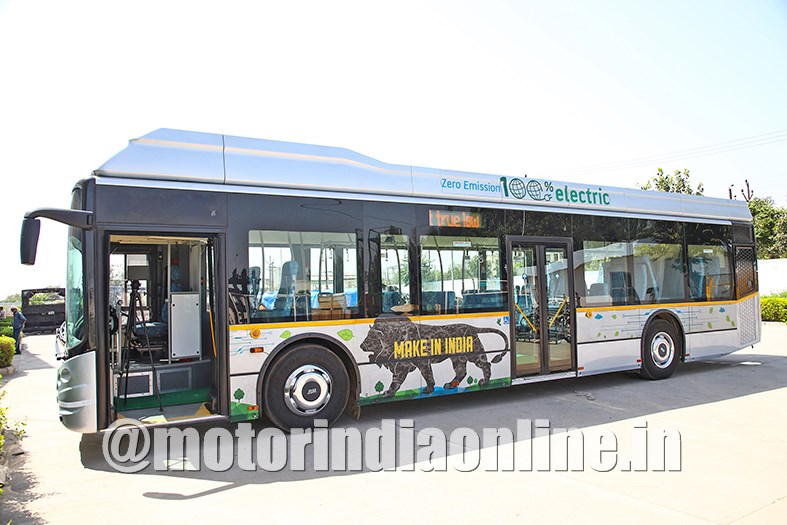
In fact, this ‘direct drive’ technology is perhaps the reason how automakers like Tesla and Rimac could build incredibly fast electric cars. Even some of the electric cars with a modest performance feel surprisingly fast enough for everyday ‘mundane’ use, and the ECO-LIFE electric bus is no different. The bus feels exceptionally agile, unlike any other low-floor models I have driven so far, and presume I will have the same feeling even when the bus is tight-packed with passengers. Further, even the slightest jerks that you find in a fully automatic bus during straight acceleration owing to gear changes are absent in this e-bus.
From the acceleration point of view, we have to keep in mind that the electric bus is a very different vehicle to drive altogether, nothing like a conventional bus. In a typical diesel-powered bus, either with manual or automatic transmission, we may have to keep pushing the gas pedal to the floorboard to achieve sufficient rpm at every gear. In other words, there will hardly be any force feedback or some kind of sensitivity attached to the pedal. Maximum power can be achieved only at higher engine speeds and so a driver is always used to heavy acceleration in large vehicles.
It took a while for me to realise that such practice is pretty ‘old-school’ and not in consonance with an EV. There is no need to rev the bus to pull away; full power is readily available at any speed. All I had to do was to blip the pedal lightly, just to supply enough power to the wheels. That’s more than enough for the electric powertrain to stabilise the acceleration and maintain cruising speeds. I once tried sudden braking at speeds over 60 kmph and the bus came to a quick standstill in a settling and soothing manner. I accelerated a split second later and the bus felt all normal and surged again with ease. Although, the bus took a fair amount of time to reach its top speed of 75 kmph, which is understandable as the bus is designed for start-stop city conditions and optimised for maximum energy efficiency.
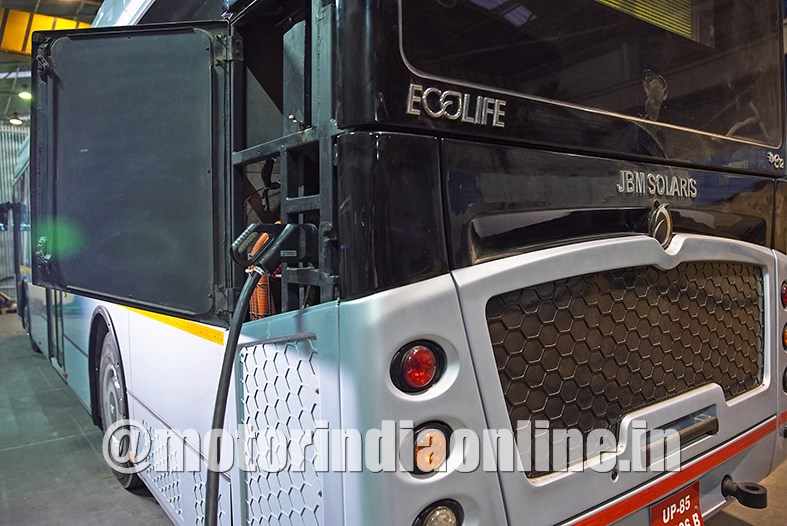
One-pedal driving
Moving on, another aspect of difference with an electric bus is its braking manner. The ECO-LIFE is equipped with regenerative braking, an essential technology to harnesses the kinetic energy of the vehicle while decelerating to extend its driving range. With this, the bus can be set up to ‘brake’ when you lift off the throttle. Some EVs let the driver adjust the regenerative braking effect to afford either greater energy recapture or a more ‘normal’ feel, but JBM Solaris has tuned it for a perfect balance. This allows for a smoother and comfortable braking experience, while also instilling confidence to the driver that the vehicle is under control even while braking at higher speeds.
After a series of braking experiences, I learned to bring the vehicle to a complete stop just by modulating the accelerator. This can prolong the life of brake pads and disc rotors, as the motors share some of their burdens. The battery-electric bus offers peaceful drive experience and does ease out things for the driver, enabling him or her to pay attention towards passenger safety and sensible driving. The steering was not too light, but quite responsive and predictable as conventional low-floor buses. Except for the high-pitched whine of the electronics that is occasionally audible, there is absolute quietness on the move. A certain amount of road noises out of tyres and undulating surfaces does creep into the saloon at higher speeds, but far better than what one would undergo in a mid-luxury passenger car!
On the other hand, it is astonishing to see that anything and everything on this bus is powered by the battery source. We are so used to a particular way of thinking about energy generation in automobiles that certain facts do seem unconvincing. Even high-energy equipment like power-steering, air-conditioning, electronically-controlled air suspension (which does kneel and ascent back superbly, considering the beefiness of this vehicle), air compressor for the braking system and so on are all powered by the battery pack. In-cabin electrical systems like lighting, CCTV cameras and entertainment system are all connected to standard 12 V lead-acid battery similar to the one fitted to a combustion engine vehicle.
Moreover, a sense of range anxiety is very much ingrained in our old-school thinking. All through the time when I was behind the wheels, I kept a strict vigil on the SoC dial, which is equivalent to a fuel gauge in EVs. But the electric bus didn’t behave like a used mobile phone; the charge percentage did not drop as quickly as I was anticipating even after hours of shuttling back and forth the test track. Nor did the system temperature rise even slightly, in spite of plying around in scorching daylight sun.
Blue-sky future
In a nutshell, the drive experience of JBM Solaris electric bus makes me rethink my ingrained sense of driving. It offers whole new thinking about driving and demands one from the driver as well. Electric buses may seem simple and ordinary, but underneath the skin, they are very different. They feel different on the road than conventional buses, while their driving demeanour differs significantly. Drivers like me will take some time to get used to such buses for the lack of internal and engine noises, as traditionally, the noisier a vehicle is the more powerful and speedy it is considered. Electric buses are nothing less than diesel or CNG buses.
On the contrary, they are setting a giant leap in bus driving in terms of ease of operations, improved driveability and performance, and enhanced safety, all with a silver-lining of being emission-free. No doubt, one key aspect that e-buses seemingly succumb to the vibrancy of the conventional diesel buses is the reliability of charging infrastructure for seamless running. Take, for instance, the JBM Solaris ECO-LIFE 12M can be charged by two means, either via a plug-in charger or overhead pantograph. But where can I find infrastructure to support any of the two options, once I drive away from the bus maker’s facility? At least, in this case, JBM Buses is actively supporting its customers to set up the required charging infrastructure for the electric bus. However, common charging stations in city spaces or along the highways are still a distant dream.
But with too many advances happening in the domestic market for e-buses, who knows what tomorrow may bring! Okay, may not be tomorrow, a day after, or a decade later as well. But the transition of bus transport towards electric has already begun one way or the other and will usurp all brouhaha in the decades to come.
